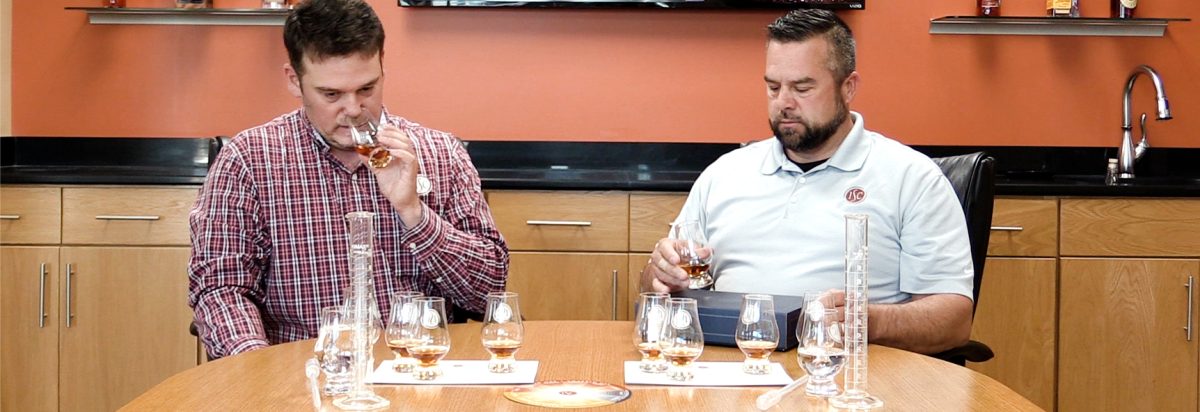Five Tips to Become a Master Taster (for People in a Hurry)
By: Andrew Wiehebrink, Independent Stave Company Director of Spirit Research and InnovationLearning to taste whiskey on a serious level can be a daunting task, especially for folks that are just beginning their whiskey journey. The vast array of overinflated tasting notes and flamboyant descriptors that can be found in books or on the internet can be overwhelming. There are lots of tips and tricks to tasting whiskey, but most seem to miss the big picture. You will find things such as, “open your mouth when you smell the glass” or “start out at a lower proof”. You’ve probably seen this one before… “add a little water to each sample”. These are all valid tips but as I said above, really miss the big picture when it comes to embracing the art of being a solid evaluator of barrel aged spirits.
So, today I thought I would share my best recommendations for accelerating your skills to the next level in a big hurry. Some of these may seem a little boring but I promise, these tips are the best thing you can do to build a solid base for developing your ability and holding the coveted title of master taster.
Tip Number 1: Break through the wall
Before we ascend the throne to master taster, this painful test of honor needs to happen. This one is championed by my buddy Lew Bryson and it’s a must. They say a taste for whiskey isn’t acquired, its earned. Very true words in my opinion. Whiskey, or any alcohol for that matter, is very difficult to taste on a professional level. With barrel aged spirits, the alcohol content is high and some of the flavors are in relatively low concentrations. The alcohol content proves to be a significant obstacle to overcome for most. But it is a necessary one to overcome if we want to get to the plethora of flavors hidden in barrel aged spirts. Hence, we must “break through the wall”. Simple instructions, but often difficult to do. A glass of whiskey, neat, every night for at least five to six weeks. And I do mean every night. This will get your palate acclimated to the heat from the alcohol. It varies from person to person as to how long it will take, but eventually, the alcohol fades away and out of nowhere, you will start picking up some yummy flavors. Once we conquer this, the fun really begins.
Tip Number 2: Keep things simple and work your way up
Stale grape jolly rancher, fresh mown summer grass, saddle leather soaked in three-day old coca cola…all of this sounds fun and exciting, but these are very advanced tasting notes that you need to work your way into. Nobody, and I mean nobody, is able to pick up these things as a beginner so don’t even let this bother you. Eighty percent of what you taste is whatever your mind is telling you taste. For now, focus on the other twenty percent, or what your physical senses are actually detecting. How do we do that? Work with a basic and proven set of flavor markers as your descriptors; skip the fancy stuff. These are singular flavor characteristics that we know exist in barrel aged spirits. I’ve listed my suggestions below but choose your own and make sure they are characteristics you enjoy. Once your skills begin to improve, you can start playing with the mental aspect and really start bringing in some very specific and descriptive tasting notes. Be patient and don’t lie to yourself.
- Sweet
- Spice
- Smoke
- Oak
- Fruit
- Floral
Tip Number 3: Know what you are looking for before you taste
Have you ever tried doing a word search without the list of words you are supposed to find? Its significantly more difficult than doing one with a list. Same thing with tasting whiskey…if you pull a glass of whiskey to your nose and simply wait for descriptors to present themselves, it is going to be a little more difficult to pull the notes out. Whenever I taste, in my mind I am thinking of the descriptors I listed above. For example, lets run through ‘sweet’, which is normally the first thing I look for. I will pick up the glass, think of sweet flavors, then pull the glass to my nose and see what I can match up. This seems trivial but keeping descriptors running through your brain as you taste makes things quite a bit easier.
Tip Number 4: Always taste at least two different samples at the same sitting
This is valuable advice especially when first beginning to develop your skills. Most novice drinkers have a tough time pulling out flavors from a glass and this little trick can make that task a little easier. Differences in overall flavor profiles are much easier to spot than individual flavors. As such, I find that if I can first notice a difference between two samples, it makes picking out the flavors a little bit easier. There has to be a reason why you like one over the other. What is it? You might say that one is sweeter. Ok, now focus on sweet and pull out a descriptor. Vanilla, caramel, butterscotch…really focus on what might be causing the difference.
Tip Number 5: Taste with friends
Last but not least. This one is a no-brainer but definitely worth mentioning. Have you ever been nose deep in a glass of whiskey and one of your buddies yells out, “I smell banana”, and then suddenly you can smell banana? Happens to me all the time and this phenomenon is the easiest way to lock into a flavor descriptor and capture the resulting aroma in your tasting note arsenal forever. This really dives into that eighty percent metal aspect of tasting but that’s perfectly fine. Maybe your friend was full of it, and he just shouted something random. No problem, as long as you legitimately detected that aroma after he shouted it out, that’s the only thing that matters. You now have an idea of what banana aroma should smell like in whiskey and it’s locked in for future tastings.
To those beginning their whiskey journey, I hope these tips helped and to those experienced drinkers out there, I would love to hear your comments. Did I miss anything? Shoot me a line and let me know.
Cheers!
Andrew


